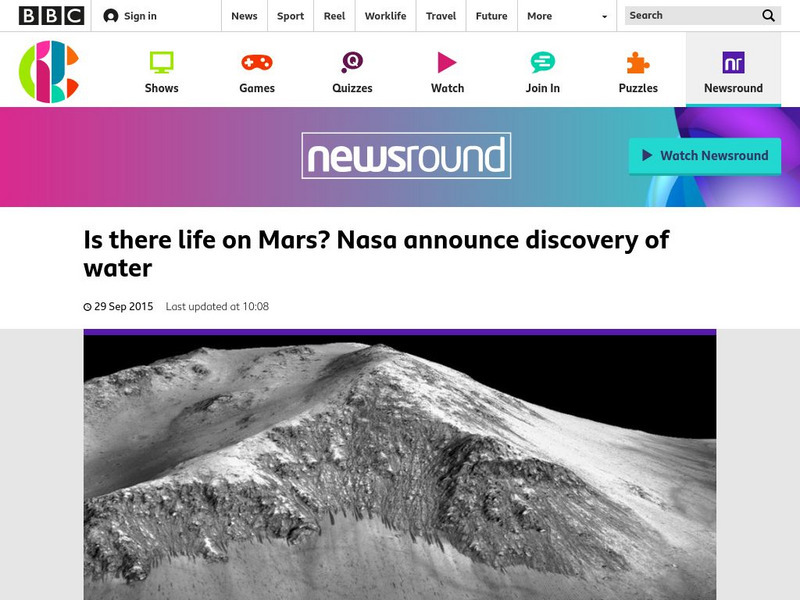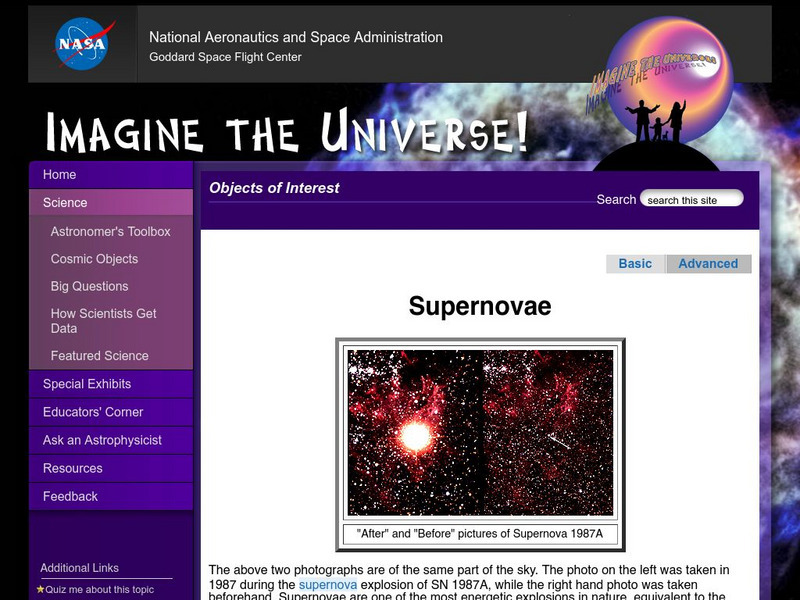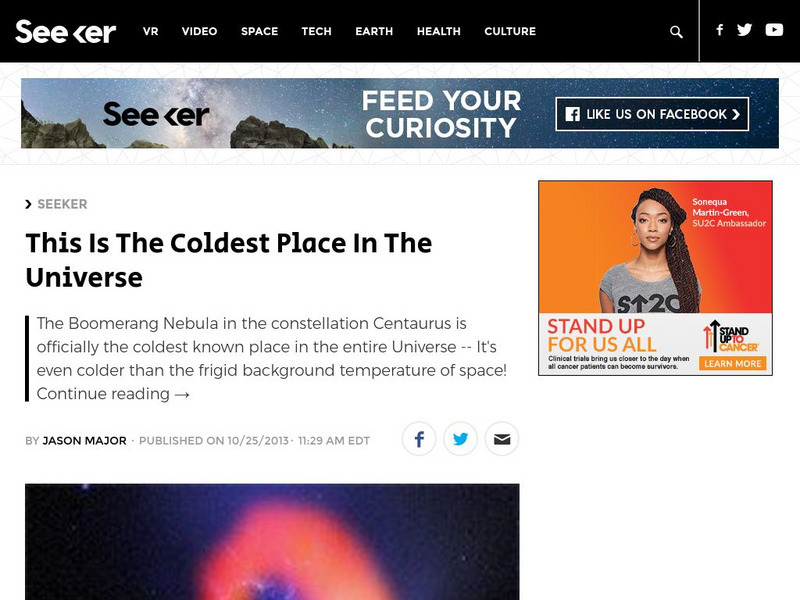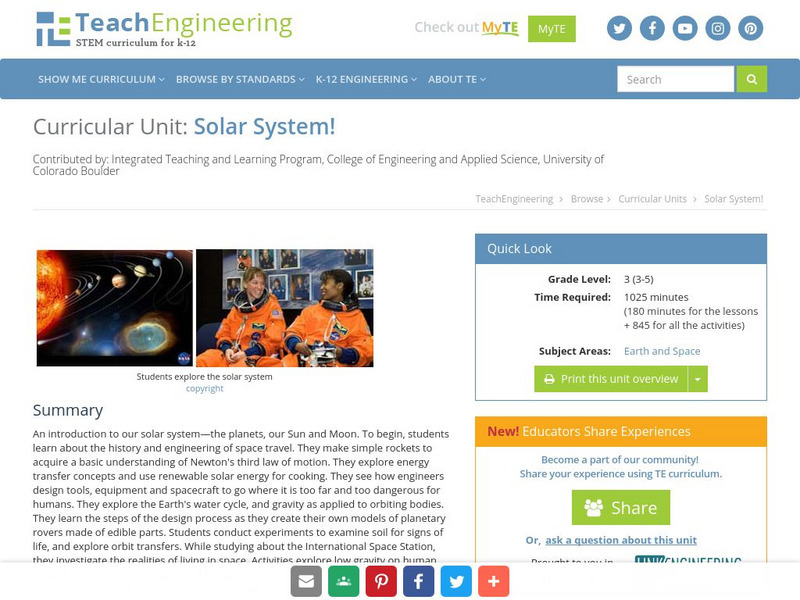NASA
Astronomy Picture of the Day: Quasar Galaxy Collision
An image of a quasar. The large redshifts imply that quasars lie near the edge of the observable universe and must emit tremendous amounts of energy. There are also many embedded links to related topics.
NASA
Astronomy Picture of the Day: Supernova 1987 A
Details of the brightest supernova of modern times - supernova 1987A in the Large Magellanic Cloud. There are many links for additional information.
NASA
Nasa: The Space Place: Looking for Water Everywhere!
NASA has discovered water in space. This interactive resource allows you to examine the different planets and moons in our solar system to find out where their water is located.
BBC
Bbc Newsround: Is There Life on Mars?
This site provides several reports on NASA's discovery of water on Mars.
BBC
Bbc Newsround: Top 5 Amazing Space Discoveries
Read about some of the most important space discoveries in recent times.
DOGO Media
Dogo News: Spacewalks Have Come a Long Way in Fifty Years!
Learn about the evolution of spacewalking over the last fifty years. Includes video.
Other
Centre National D'etudes Spatiales
The official homepage of France's national space organization.
BBC
Bbc Newsround: Special Waves From Black Holes Discovered
Learn about the discovery of gravitational waves made from two black holes colliding over a billion years ago!
NASA
Nasa: The Space Place: How Old Do I Look?
Find out how the Galex space telescope is determining the age of galaxies using red-shifted light. View pictures taken by Galex. This resource also has a game which involves determining the ages of objects.
NASA
Nasa: The Space Place: Planet X Treme Weather
Ever wonder what the weather is like on other planets besides Earth? This resource explores the extreme weather that occurs on other planets.
NASA
Nasa: The Space Place: What's in the Heart of a Comet?
NASA site explores what a comet's nucleus is composed of. Animation and photographs are provided as well.
NASA
Nasa: Imagine the Universe: Fa Qs on Quasars
A list of answers to many questions related to quasars and active galaxies.
NASA
Nasa: Imagine the Universe: Supernovae (Basic)
A detailed description of a supernova developing from a single massive star. There is a quiz, related links, animation, lesson plans, and an FAQ sheet available also.
NASA
Nasa: Imagine the Universe: Active Galaxies and Quasars
Describes quasars as being classified within the category of an active galaxy. A description of the emergence of high-energy. Definitions of key words are provided.gamma-ray quasars as an important component of the gamma-ray sky.
NASA
Nasa: Imagine the Universe: Supernovae Remnants
A brief description of supernova remnants with many embedded links to help define terms used in the description. The specific topics are age and the importance of remnants to us and the types. Definitions of key words are provided.
NASA
Nasa: Imagine the Universe: Supernovae (Advanced)
Supernovae are divided into two basic physical types, including a description of supernova types and how they are classified based on the existence of hydrogen spectral lines. Definitions of key terms are provided.
NASA
Nasa: Imagine the Universe: X Ray, Gamma Ray Astronomy
Frequently asked questions are answered about gamma rays.
Seeker
Seeker: Week of 10 28 13: This Is the Coldest Place in the Universe
Article reports on the discovery by scientists that the Boomerang Nebula in the Milky Way is the coldest known place in space.
Seeker
Seeker: 'Doomsday' Ripples Through Galaxy
Learn about a storm errupting in the Teacup Galaxy involving the explosion of a supermassive black hole.
Other
Indian Space Research Organization
The official homepage of India's Space Research Organization.
TeachEngineering
Teach Engineering: Solar System!
An introduction to our solar system: the planets, our Sun and our Moon. Students begin by learning the history and engineering of space travel. They make simple rockets to acquire a basic understanding Newton's third law of motion. They...
TeachEngineering
Teach Engineering: Space
In this unit, students first are introduced to the historical motivation for space exploration. They learn about the International Space Station and are introduced to new and futuristic ideas that space engineers are currently working on...
TeachEngineering
Teach Engineering: Space Travel
Students are introduced to the historical motivation for space exploration. They learn about the International Space Station as an example of space travel innovation and are introduced to new and futuristic ideas that space engineers are...























